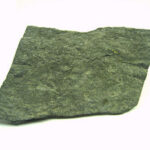Metal
Copper, Tin, Zinc, Aluminum, Steel are all used as roofing materials. With the exception of the last two mentioned, metal roofs have been around for hundreds of years. They come in two basic shapes- sheets that attach at the seams, and shingles.
The pros are that metal roofs, properly maintained, last 50-100 years or more. Some roofs with special coatings qualify for the energy star roofing rebate program. The metal can be manufactured to resemble slate, traditional or clay tiles. They are also fire resistant, and made to withstand high winds and hail.
The cons are that special underlayments may be needed, adding to the cost. Battens or nailing strips may also be needed. The overall cost of metal roofs is high, but since you may need only one roof for the house’s lifetime (or yours), it’s not so bad.
Sold as shingles with two or three tabs, sheets or architectural (3-D), asphalt shingles are the most widely used roofing materials today. Available with energy star rated coatings in a plethora of colors and designs, you can have a roof that matches your home perfectly.
The pros are easy. Asphalt shingles are far cheaper than any other roofing material. This is a DIY project, and many other types are not. No special flashing or underlayments are needed, and everything you need is available from your local DIY store.
The cons are that nothing lasts forever. Especially asphalt shingles. In the hot sun, or with a strong storm or hail, they are battered to pieces. In some areas, 10-year roofs only last from 3-5 years, and 30 year rated shingles last at most 12-15 years. Some are treated for fire resistance, but will burn if the house does.
Clay tiles
Clay tiles have been in use for centuries. Usually cylindrical in shape, they resemble a “U,” because water runs off the top tile and down the center. Fire resistant, bug resistant and beautiful, they often last far longer than 100 years.
Pros- they are approved in California for earthquakes, and they look stunning on houses of Spanish design. Many other clay designs are available. The tiles are considered eco-friendly, as they are made from natural materials. Impervious to bugs, mold or mildew they seldom need replacement if cared for.
Cons- price is one of the largest cons to clay tiles. The roof trusses must be able to hold the massive weight, as clay tiles are not light. If a roof needs to be rebuilt for clay tile installation, the cost must be figured in first. Another question the contractor will need to know is if the walls can hold the weight of the roof. Most stick frame (2-by-4) houses won’t hold a clay tile roof without a rebuild.
Wood tiles
The wooden cedar shakes of the past resemble the houses of our Nation’s founders and all the pioneers. No need to worry about disposal, they simply go to the compost when they’ve outlived their usefulness.
Pros- they look stunning on historic houses, and in some areas controlled by historical societies, they are the only material allowed. Some of the tiles may be treated for UV protection and/or fire protection.
Cons- the cost can be prohibitive, especially if a large roof needs to be redone. The wood is at the mercy of the elements, bugs and animals. A wood roof needs constant monitoring for soundness.
Gravel and Tar
Mostly used for businesses and tall buildings with flat roofs, an underlayment is installed, and then hot tar is poured on the surface and covered with gravel. Proper drainage for any rain is essential so the roof isn’t weighed down.
Pros- these roofs last for decades with little maintenance. They are out of sight, and do not detract from the look of the building. The cost is minimal.
Cons- if the building has a fire, this type of roof becomes a nightmare. The tar catches fire, liquefies and pours down on the inside of the building. Firefighters are at high risk for injury or worse from these roofs. Many municipalities have banned them because of the fire risks.
Concrete tiles
Beautiful, and made to resemble slate or clay tiles, they last over 100 years. Many colors are available to the homeowner.
Pros- the price has become competitive in the last few decades as petroleum prices rise. (Asphalt shingles and tar roofs are petroleum products.) Concrete tiles of more than one color may be used to make the house stand out in style.
Cons- the same cons as for clay tiles applies here. Concrete is heavy, and needs a roof that can hold the weight. On the other hand, a roof you only have to put on once every hundred years isn’t a bad deal.
Composite materials
Composite roofing materials made from recycled plastics are gaining ground in today’s housing markets. With additives for UV protection, they are manufactured to resemble traditional shingles, slate, clay tiles or just about anything the homeowner desires. Any color is possible. They will not chip, warp, pop off the roof like asphalt shingles.
Pros- the price of these tiles is gaining ground in the roofing market. Impervious to hail, bugs, mildew, or mold, these shingles will last 30-50 years or more with minimal maintenance.
Cons- this is not a DIY project. These materials need to be installed by trained professionals. This adds to the cost of the overall project. Special nailer boards may need installation, and special underlayments may be needed.
Slate
Slate is a natural material because it’s essentially rock. Slate roofs have been in use for centuries. They age wonderfully and the look is priceless.
Pros- they wont’ burn, curl, warp or chip in the wind or sun. No bug, animal, mold or mildew makes a difference to these wonderful shingles. An annual power wash and visual inspection is all that’s needed. If a shingle or two needs replacement, it’s easily handled by a professional.
Cons- definitely not a DIY project. Professional roofers licensed to handle slate shingles are needed for the installation, and again slate is a heavy roof. The structure needs to be able to support it. Slate is not a renewable resource, since it is taken from the earth and not replaced.
Thatched roofs
Not found in too many places in the United States, but many houses in England still have them. These are beautiful works of art, and can last well over 100 years. Straw or other vegetation is placed on the roof and secured so that water runs off. The vegetation is packed tightly so air and moisture cannot enter and cause rot. The top of the roofs often have a pattern woven in the straw- this is the signature of the thatcher, or roofer. I lived in a house with a thatched roof when I was stationed in England in the Air Force.
Pros- these roofs use renewable, sustainable materials, as they have for centuries. The look is rustic and natural. They are still in use around the world today.
Cons- they need yearly maintenance, and if there is an infestation of rodents or bugs, the occupants of the house won’t be happy. Also, if moisture makes into the straw, the molding process generates a great deal of heat, which can lead to a spontaneous fire. As such, they aren’t in use in the United States for general housing.
Before deciding to change your roof, check with your local ordinance or historical board to find out what you can and can’t use. One of these wonderful products will fit the bill.
Now that you have several choices, imagine your roof in different colors, shapes or materials. Many warranties are transferrable from one homeowner to the next, making a long-lasting material more desirable. And it adds to the resale value of the home. Some insurance companies will give a discount for fire resistant materials- it’s worth asking about.
Source: The author of this article has over 40 years of experience in diverse forms of DIY, home improvement and repair, crafting, designing, and building furniture, outdoor projects and more.



